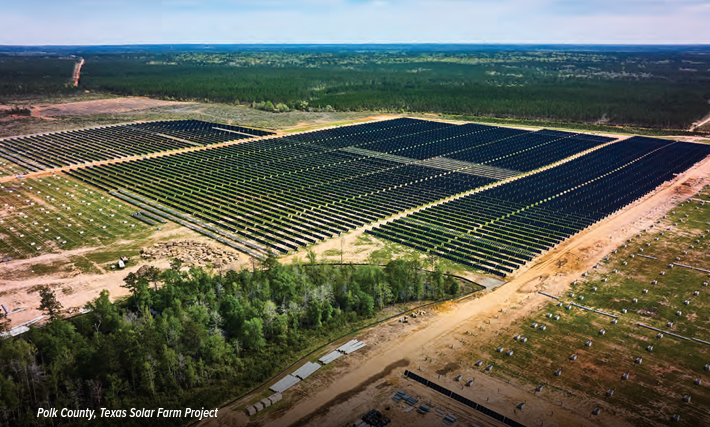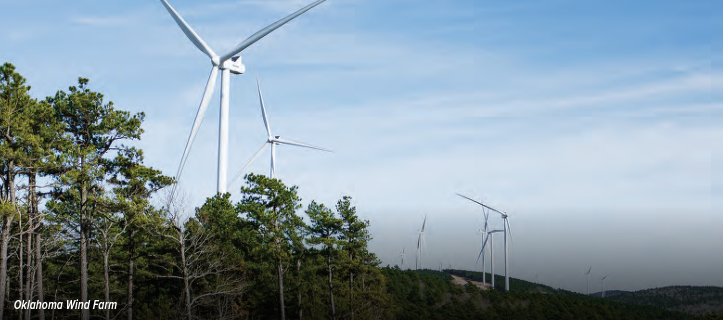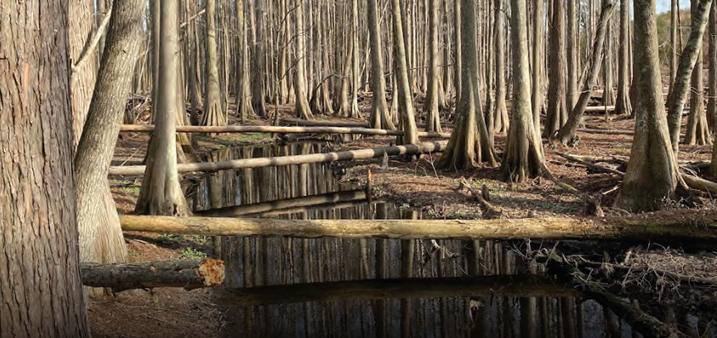Rayonier 2022 Sustainability Report: Land-Based Solutions
Published 10-16-23
Submitted by Rayonier

With the ever-increasing urgency to address the impacts of climate change and the recognition of the role forests play in sequestering atmospheric carbon, owning timberlands has taken on many new dimensions.
The list of emerging opportunities and related interest from potential counterparties for the land-based solutions offered by Rayonier's forestlands are growing, and we are allocating meaningful resources towards advancing these opportunities. As we evaluate these value creation opportunities, we are also working closely with business developers, as well as local communities, to establish safeguards and promote best practices with respect to sustainable forestry and environmental stewardship.
While the range of land-based solutions is ever-evolving, they generally fall into the following broad categories: (1) alternative and/or additional land uses, such as solar farms, wind farms, or CCS; (2) opportunities to monetize the carbon sequestration in tree growth through compliance and voluntary carbon markets; (3) increased demand for wood fiber in bioenergy and biofuel applications; (4) increased demand for wood-based products, such as mass timber; and (5) environmental and biodiversity preservation and enhancement programs.
Alternative/Additional Land Uses
Growing demand for alternative energy (e.g., solar and wind) and carbon capture and storage solutions has translated to increased demand for lands that are suitable for such uses. Our land base, particularly in the U.S. South, contains a significant amount of acreage that may be suitable for these alternative, higher-value uses, and we currently have various projects either underway or under consideration on our lands. Generally, we do not undertake project development or direct investment in these projects, but rather look to enter into long-term lease/license arrangements with counterparties. We believe that the responsible use of our land can play a vital role in addressing the climate crisis, and we are excited to be at the forefront of this effort.
Specific examples of our recent activity in this area include:
Solar Development
During 2022, we executed our first solar lease project located in Polk County, Texas. The 600 acres we currently lease are part of a larger 2,800-acre project, which at completion will produce 200 megawatts of clean energy—enough to power over 30,000 homes and avoid emissions of approximately 250,000 metric tons of CO2 annually. More broadly, solar developers regularly express interest in our land, and as of year-end 2022, roughly 26,000 acres of our U.S. South ownership was under active agreements or options for potential solar development.
Carbon Capture and Storage
In early 2023, we entered into our first CCS lease. CCS technologies allow for the safe storage of carbon dioxide captured from industrial sources, such as power plants, in natural geologic formations deep underground with minimal impact to our timber operations, non-timber income, and other land-based solutions businesses.

Carbon Markets
Forest carbon offset markets have attracted significant attention in recent years, and we’ve gained considerable experience in this area through our New Zealand Timber segment. New Zealand operates a regulated carbon offset market known as the New Zealand Emissions Trading Scheme, in which registered forests established after 1989 generate carbon credits, or New Zealand Units (NZUs), after a forest has been established and while it grows. A portion of these NZUs are relinquished when the forest is harvested. Over time, unencumbered NZUs can be sold to GHG emitters, who are required to buy and retire NZUs to offset their GHG emissions. At year-end 2022, we had an inventory of 1.6 million unencumbered NZUs, from which we expect to sell units from time to time into the open market. In 2022, for example, we generated $20 million of NZU carbon credit sales.
Unlike New Zealand, the U.S. does not have a regulated carbon credit market and instead relies on the voluntary markets. Demand in the voluntary carbon market is projected to grow significantly in the coming years driven by corporate net-zero commitments and the corresponding need for negative emissions (i.e., carbon offsets) to meet these commitments. Given the current high cost and limited scalability of technology-based removals such as direct air capture, we believe that land-based removals/offsets will play an important role in the transition to a low-carbon economy.
Most U.S. forestry carbon offset projects are based on Improved Forest Management (IFM) standards, through which a timberland property is managed differently than in the past in order to generate carbon additionality. This might include extending rotation lengths, growing different species, or otherwise managing the land in a different manner. Carbon credits can also be generated from afforestation activity, where land that has been in alternative uses such as farming or grazing is converted into forests. The carbon additionality of afforestation projects is considered to be superior to that of IFM projects, so such credits are typically worth considerably more in carbon credit markets. Rayonier is currently working on both IFM and afforestation carbon credit projects in the U.S.
Fiber for Bioenergy/Biofuels
Bioenergy and biofuels will likely play an increasing role for many industries aiming to provide and/or source lower-carbon energy. To this end, we are seeing growing interest from potential counterparties looking to secure fiber for bioenergy and biofuel manufacturing facilities.
For example, there are currently a number of bioenergy with carbon capture and storage (BECCS) facilities under consideration in the U.S. South. BECCS facilities burn woody biomass for energy production, and then capture and store the emitted carbon—thereby creating a carbon negative cycle. These facilities could drive significantly increased demand for wood fiber within a proximate sourcing radius.
We are also seeing significant interest in woody biomass for sustainable aviation fuels. Air travel is currently a significant driver of GHG emissions. SAF blended with conventional jet fuel can be used in existing aircraft and result in fewer emissions. Demand for (and production of) SAF is projected to grow rapidly over the next several years, as many of the major airlines have made commitments to utilize an increasing mix of SAF in the future.
While some of these opportunities are still relatively nascent in their development, they reflect the increased future optionality and competition for wood fiber given the positive environmental attributes of timberlands.
Growing Use of Wood-Based Products
In conjunction with the shift toward a low carbon economy, we anticipate that the demand for wood-based building products and packaging will increase moving forward. Life cycle assessment studies have demonstrated the benefits of carbon storage in wood-based building products—that is, fewer greenhouse gas emissions (in construction and in use) as compared to other building materials, such as concrete and steel. Looking ahead, we are optimistic that wood-based construction will continue to grow through the broader use and acceptance of lumber and engineered wood products, such as mass timber. Specifically, we believe that increased demand for cross-laminated timber (CLT), which is a specific type of mass timber product, will be spurred by increased usage in the commercial construction market. We further believe that wood-based packaging will continue to gain favor as an environmentally friendly alternative to single-use plastics.

Environmental Preservation
Given the increased focus on environmental and biodiversity preservation, we expect the opportunities for Rayonier to offer solutions in this area (e.g., conservation easements and mitigation banking) will grow over time. We are actively providing conservation easement solutions and closely monitoring opportunities to provide biodiversity solutions in the future. To this end, we are evaluating opportunities to enhance the biodiversity provided by our land base through our sustainable forestry practices.
To learn more, view the full Rayonier 2022 Sustainability Report.

Rayonier
Rayonier
Rayonier (NYSE:RYN) is a leading timberland real estate investment trust with assets located in some of the most productive softwood timber growing regions in the United States and New Zealand. We own or lease under long-term agreements approximately 2.8 million acres of timberlands located in the U.S. South, U.S. Pacific Northwest and New Zealand. We are More than trees because we recognize that our 90+ years of success in the timberland industry comes from our people, an empowering culture and the courage to constantly challenge “the way it’s always been done.” Get to know us at www.rayonier.com.
More from Rayonier

